Entertainment
Stellar Blade Review: No Sharp Edges
Published
8 months agoon

Good video games know what they are. A strong sense of self-awareness about their strengths and weaknesses — it could be the game’s narrative chops or its mechanical robustness — make for games that don’t suffer from an identity crisis. It also prevents games from feeling bloated and scatterbrained. But a concentrated approach can force-fit a straitjacket onto a game, as well, leaving it feeling like a one trick pony.
Stellar Blade, the debut game from Korean studio Shift Up, is also laser-focussed on its singular skillset. As an action-adventure title, it zeroes in on the action with admirable flair, but it purposefully avoids complexity in almost every other department to deliver an experience that constantly urges you forward and deeper into its combat playground with barely any meaningful distractions along the way.
If you want a more rounded experience from your video game, if you desire meaningful side quests, an affecting story and three-dimensional characters, then Stellar Blade will stop short of ticking the right boxes. But, if a 20-hour single-minded rush through monster-infested levels, adorned with kinetic action, challenging boss fights, and flashy visuals, sounds appealing to you, then it will serve exactly what it promises.
Stellar Blade is also not completely barren when it comes to ideas: its grotesque monster designs, while derivative, are interesting and often anachronistic, fitting the nightmarish world of Bloodborne more than the slick ruins of planet Earth in Stellar Blade, thus making for an unsettling experience whenever they show up; the excellent in-game music not only underscores the frenetic combat, but also accentuates the idle time between the encounters; and the game is almost perfectly paced between cascading sections of breathless action and idyllic moments of relief.
And then, there’s the much talked about character design for the protagonist, Eve, a space soldier dropped onto a post-apocalyptic Earth to save the remnants of humanity and take down the violent, monstrous species that roams the planet. Eve is designed as an E-girl, with anime eyes, flowing silky hair, voluptuous body and skin-tight outfits to match the whole persona. It’s nothing you’ve not seen in anime and other forms of online media before, but it certainly stands out in the video games medium. Games have long been accused of designing their female characters from a hyper-sexualised male gaze (think Lara Croft in Tomb Raider) and the medium has often veered into sexist and stereotypical depictions of women in general.
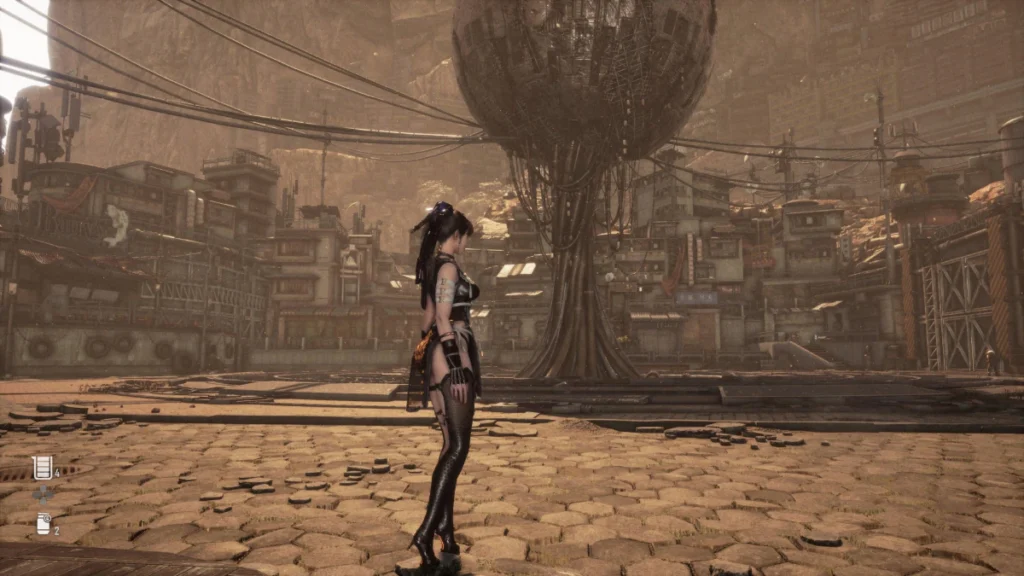
That’s not to say that games have not had iconic strong female characters — you can criticise Lara Croft’s design, but the character took a life of her own beyond video games and reclaimed her sexuality to emerge as perhaps one of the earliest and longest lasting sex symbols in the medium. And she had the personality to match. Even if you’ve not played Tomb Raider games you know of Lara as feisty, intelligent and indefatigable. It’s a testament to the characters’ aura that she later went on to be portrayed by Angelina Jolie in Tomb Raider films. The same goes for Bayonetta, another video game heroine known for her risqué character design and personality. The leather-clad witch never shies away from embracing her femininity and is just as ready to drop an indecent innuendo as she is likely to drop you dead.
The same, however, cannot be said for Eve. Her overtly sexual depiction is aggressively incongruous with her boring, flat personality. She doesn’t have the confidence and charisma to match the in-your-face suggestiveness of her character design. She’s neither as embracing as Bayonetta, nor as empowered as Lara to own her sexuality, thus making her persona feel like a hormonal teenager’s idea of what sexy is supposed to be. Heck, Eve doesn’t even have an idea of who she is. Had the designers at Shift Up paid as much attention to her personality and identity as they did to her backside, the Stellar Blade heroine probably wouldn’t have ended up seeming like a sex doll with a sword.

Stellar Blade is not aiming for narrative excellence either. There’s a functional story about an Earth left to its ruinous fate after humans lost a war to Naytibas — monstrous, blood-thirsty creatures that now infest the planet. Driven away from their home and now living in a colony in space, humans send an airborne squad of angelic warriors to defeat the Naytibas and take back what was lost.
Eve and her squad are dropped into the middle of the conflict, and we’re taken through a quick tutorial section that dives into the basics of attacking, blocking, dodging and parrying. Most of the squad is lost during a planetfall gone wrong and Eve soon loses her mentor, Tachy, to a Naytiba attack. She barely survives the Naytiba encounter herself and escapes with the help of Adam, a human scavenger who survived the initial conflict and remained on the last human settlement on the planet.
The story then takes predictable routes as Eve gathers her strength and embarks on a journey to save mankind and eliminate the Elder Naytiba, the leader of the monsters. She’s aided by Adam, who guides her way through the devastated planet, and Lily, an engineer from an earlier expedition, who crafts new gear pieces and upgrades for her. There are some twists along the way and a final-act revelation that threatens to upend the nature of the conflict itself. But the narrative never rises above being merely serviceable.
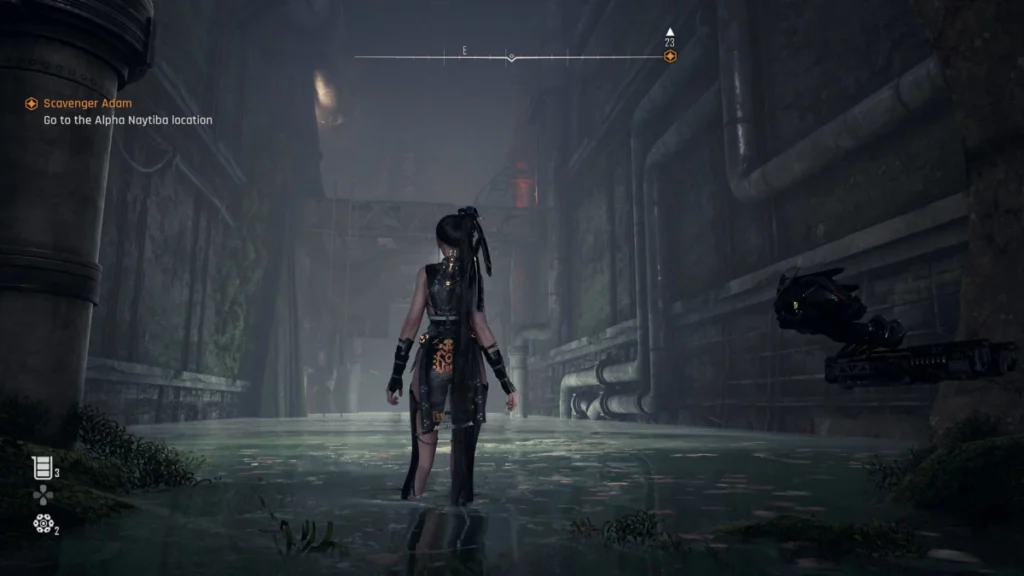
The characters lack any depth beyond the archetypes they inhabit, and the voice acting is delivered as flat as a slice of bread. The writing is mostly expository, and we barely get to know more about the people on the screen, their motivations and desires. Eve and her allies interact in robotic ways, going through the motions of their programming — they might as well talk in binary. There’s no dramatic or emotional thrust to the story and the sky-high stakes are left feeling weightless at every crucial turn. And as a game that tries so hard to be sexy, Stellar Blade is ironically completely sexless. Beyond the caricature of provocative physicality and juvenile eroticism, the game and its characters lack any real allure and sexual tension.
Eve is supposed to be this overpowered interstellar soldier with a perfectly sculpted body and an army of abilities at her disposal. She carries a sword the size of a streetlamp that she uses as a hairpin when she’s not in combat! She should be cocksure and witty, dropping foes and jokes in the same breath. But she mostly turns up meek and unsure of her own place and purpose on this planet. Eve is ostensibly presented as a dress-up Barbie meant for the male fantasy — change her cute outfits and swap out one schoolgirl haircut for another before you head to battle.
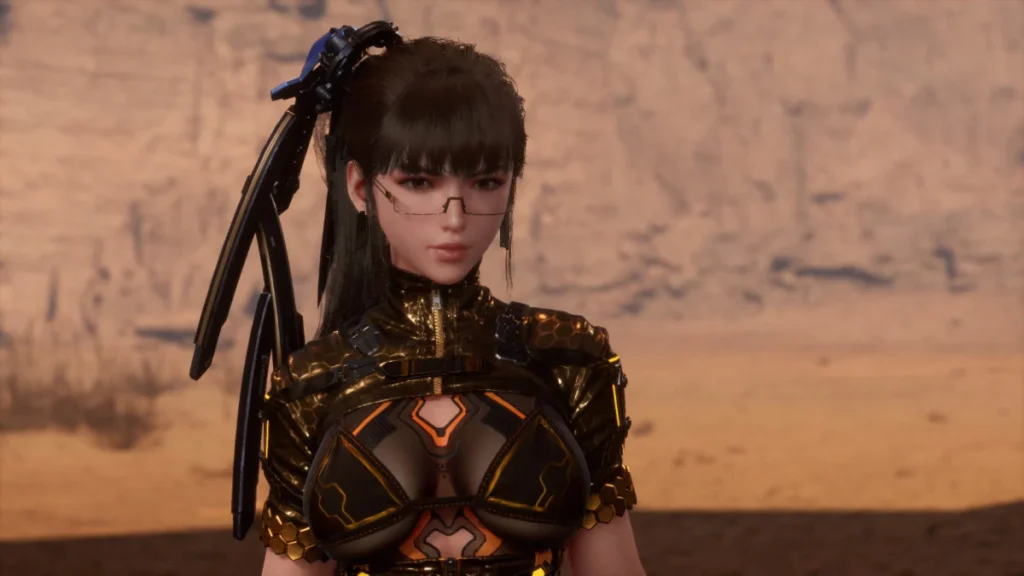
But it’s the battle part in Stellar Blade that distinguishes itself even as the rest of the parts fail to rise above generic video game design. Shift Up has acknowledged taking inspiration from PlatinumGames’ acclaimed action-RPG, Nier: Automata, both in its themes and its action. And while Stellar Blade’s combat lacks the versatility of the 2017 classic, you can clearly see the similarities in the kineticism of the moves. The combat in the game is flashy, based on chained combos and special Beta abilities that come with exaggerated animations and deal devastating damage.
The combat basics are what you’d expect: you memorise enemy attack patterns, dodge or parry incoming attacks and hit back with chained attacks linked to specific button combinations. When you dodge or counter an enemy at just the right moment before the attack lands, you execute a perfect dodge or parry and get a chance to riposte and deal back damage. These defensive and offensive actions slowly fill up the Beta gauge, which allows players to utilise Beta skills in combat. These special abilities, triggered by holding down the left bumper on the DualSense controller and pressing corresponding face buttons, come with unique animations and deal high damage to the enemy’s health or shields.
Later in the game, you also unlock Burst skills, activated by holding down R1 and corresponding face buttons, that result in massive area-of-effect attacks capable of inflicting damage to multiple foes. These are some of the flashiest moves in Stellar Blade, usually accompanied by a long winding-up animation and an explosive impact.
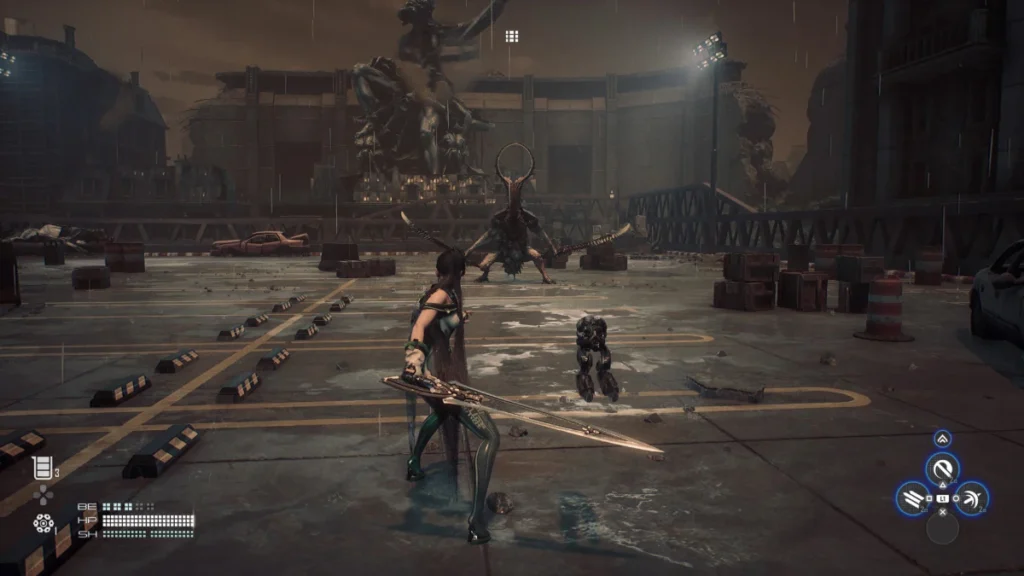
Aside from these special abilities and melee attack combos dealt with her sword, Eve also has a variety of ranged attack options at her disposal. You begin with a selection of grenades that deal damage to enemy health or shields and later upgrade your drone to double as a versatile firearm that can discharge standard slugs, a charged laser attack, homing missiles, shotgun shells and more. Upgrade modules obtained via exploration and combat lets you further enhance the capabilities of the firearm. While these ranged attacks don’t quite replace the melee combat, they bring a bit of handy firepower that can be used in tandem with the sword attacks.
Stellar Blade also allows for a bit of perfunctory stealth: you can slowly walk up behind an enemy or position yourself on a ledge above them and hit the triangle button when the contextual prompt comes up on the screen to execute them in a single blow. These executions replenish the Beta gauge and once upgraded, can be chained together to take down multiple enemies. These stealth interactions, however, are a bit clunky and you can sometimes end up not locking into the contextual execution action and instead trigger a standard heavy attack and alert the enemy of your presence.
The platforming and exploration sections in Stellar Blade suffer from similar jank. While general movement in the game — running, sprinting and jumping — work as expected, when a combination of these is required to be performed with precision in specifically designed platforming sections, the game just falls apart. The game loses all fluidity and slickness during these sections and Eve feels like she’s been straitjacketed with her animations feeling stiff. Some of these platforming sections are also functionally broken. Later in the game, you unlock the wall running ability and soon meet platforming sections where you have to chain wall runs to reach across wide gaps. I didn’t die in the entire game as much as died in these sections. Jumping off a wall run into another is so imprecise and clunky that these sections grate against the general slickness of the rest of the game.
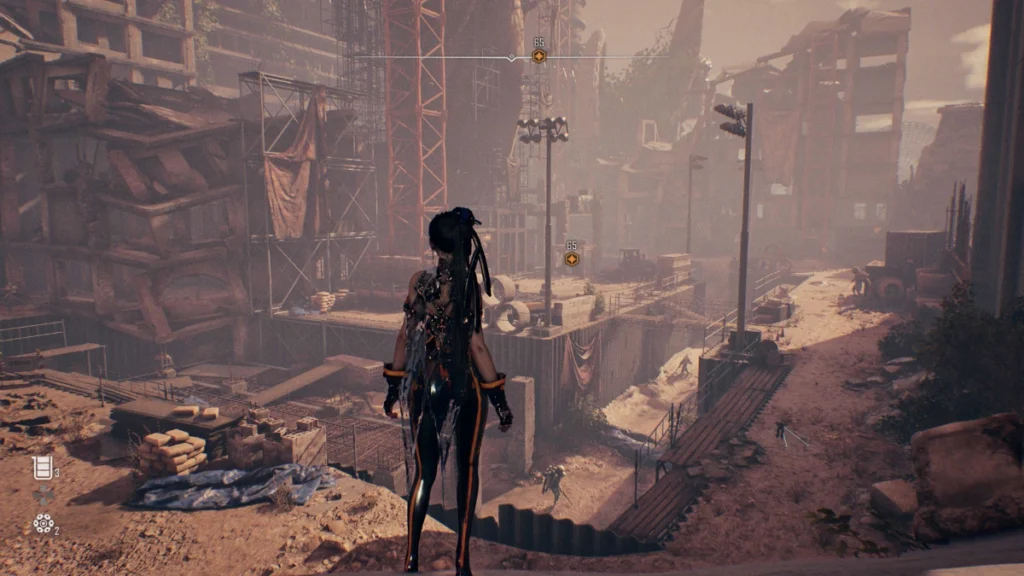
Action games live and die at the altar of their combat systems, and with story and characters taking a backseat in Stellar Blade, the scrutiny falls onto its action gameplay. Here, Shift Up’s game gives a good account of itself. Combat in stellar blade is weighty, but never weighed down. There’s a satisfying crunch to the action, but it also feels flowing and freeform. While attack inputs are limited to a standard and a heavy attack, there are enough combos here for attacks to not feel repetitive. Beta and Burst skills bring a bit of flair to the combat and meaningful skill tree updates keep bringing new abilities to the table.
While the general design of the Naytibas is limited to a select few foes that keep repeating across levels, it’s the boss encounters that truly stand out. Bosses in Stellar Blade have distinct monstrous designs and require you to be quick on your feet and smart about when you choose to stop being defensive and attack. To be clear, these fights are nowhere near as difficult as the ones in Soulslike games, even though Stellar Blade adapts a few tenets from the genre and presents them in a more accessible way. But these encounters are always thrilling and fun, and the excellent visuals and rousing music help sell a sense of scale and a feeling of “this s**t is epic and cool!”

But what I enjoyed more were the moments of idyllic relief that punctuate these kinetic encounters. Before and after taking on big, mean bosses or groups of enemies lining a particular section of the level, you come across camps that let you rest and replenish your consumables. These camps essentially act as bonfires from Dark Souls, offering a relief from the dangers that litter the map, but also respawning Naytibas you’ve slain in the level once you sit down and rest.
Beyond the functional purpose of the camps, however, I was more taken by their aesthetic appeal every time they popped up in a level. They are presented as a curated space evoking a nostalgic idea of recreation. There’s a cozy chair, a record player playing chill tunes that you can cycle through, a vending machine that acts as shop for items and consumables, and a giant parasol covering it all to give a sense of a beach vacation or a lazy weekend in the backyard. The camps themselves aren’t novel at all, but their visual juxtaposition against the monster-infested ruins of planet Earth creates an interesting motif.
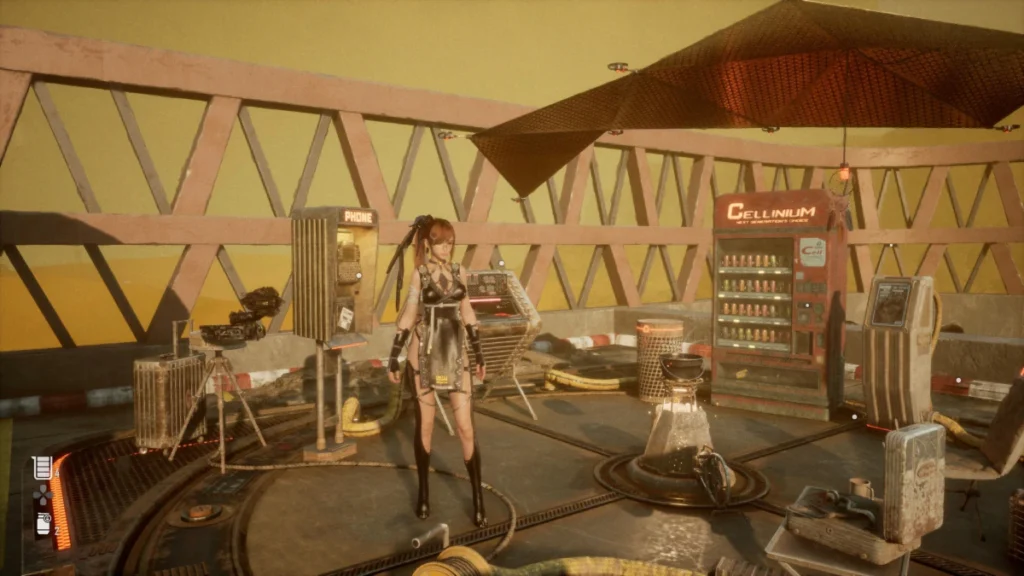
Stellar Blade shines in the visual department in general, too. Even if there’s little personality to the art design, there’s a staggering amount of polish to everything on screen. The game’s representation of a post-apocalyptic planet is rarely fresh, and you can see it borrowing ideas from different forms of media that have come before. But it all looks so good! Walking through ruined city blocks and dimly lit, dilapidated interiors is an immersive experience. And Stellar Blade also often pauses at certain points to let you admire the apocalypse, presenting stunning vistas of a devastated planet. The linearity of the game, too, lends itself to the graphical fidelity seen across levels, each of which brings a distinct aesthetic.
Stellar Blade is not an open-world game, but it does open up after the first act of the story when you reach the last surviving human settlement of Xion. Here, the game lets you indulge in some dull and repetitive side quests and presents, for the first time, a map of the open section to let you explore the city and its surrounding wilderness. It’s telling, but not surprising, that this open area feels lacklustre compared to the more compelling visual aesthetics and design of the linear levels. Stellar Blade is a PS5 exclusive and the performance on the console remained consistent for me, with expected framerate dips in demanding sections. It would, however, be an ideal candidate for a PC port down the line, with its slick graphical presentation an ideal fit for the platform.
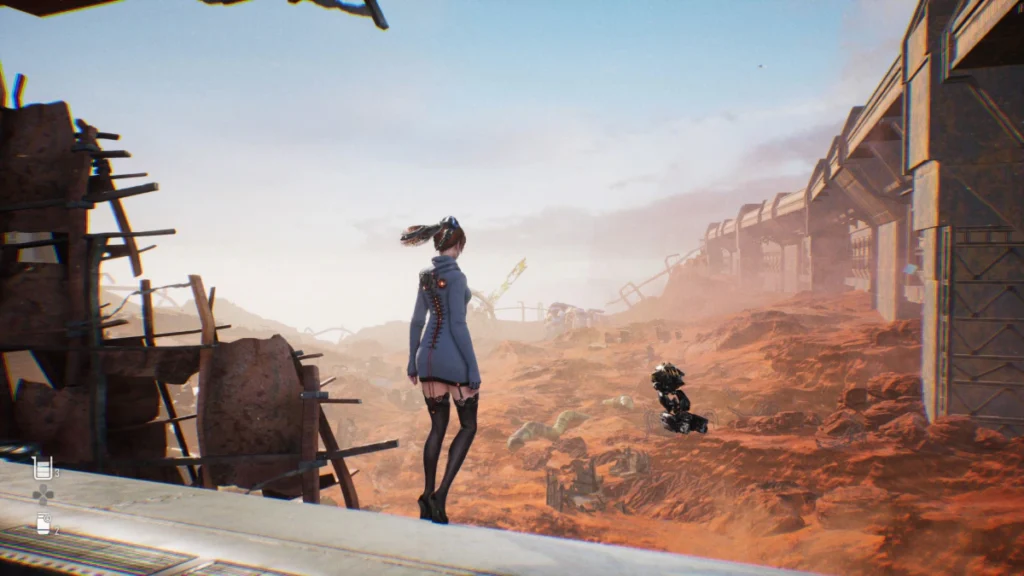
When it comes to action-adventure titles that put their combat systems in the spotlight, Stellar Blade has entered a very competitive field. By de-emphasising narrative, characters and ancillary gameplay features, it attempts to go toe-to-toe with games that focus on real-time melee combat. But it also pales in comparison to action-heavy games like Devil May Cry, Bayonetta, Nier, and Final Fantasy. And it doesn’t help Shift Up’s cause that these titles also bring more than just fun hack-and-slash combat to the table.
DMC and Bayonetta games have always had a distinct personality, and Final Fantasy, despite leaning towards real-time action combat in recent titles, has always placed its strong characters, meaningful RPG systems and sprawling stories front and centre. Stellar Blade doesn’t do that. Shift Up has also clearly tried to appeal to a certain sensibility with its lead character design. However, a protagonist provocative on the surface, but completely unremarkable in every other layer beneath can only carry the allure so far. Eventually, Stellar Blade is held up by its fun combat and slick presentation, but it’s consistently held back by almost everything else.
Pros
- Fun and flowing combat
- Slick visual presentation
- Excellent music
- Engaging boss fights
- Camps!
Cons
- Weak story and characters
- Overtly sexualised character design
- Lack of meaningful side content
- Repetitive encounters
Rating (out of 10): 7
Stellar Blade released April 26 exclusively on PS5
Pricing starts at Rs. 4,999 for the Standard Edition on PlayStation Store for PS5.

Stellar Blade
You may like
Business
ChatGPT: Here’s All You Need to Know About the AI Chatbot
Published
7 months agoon
September 30, 2024
The internet is abuzz with the hype around ChatGPT, one of the most recent advancements in technology. With the ChatGPT AI innovation gaining approximately one million users in just a few months from its launch in November 2022, it seems that its market is geared up to expand at an even faster rate.
What is ChatGPT?
ChatGPT (Generated Pre-trained Transformer) is an AI-based chatbot system that uses NLP (Natural Language Processing) to generate conversations. It was developed by San Francisco-based artificial intelligence company OpenAI.
ChatGPT, a Large Language Model (LLM), has a remarkable ability to interact in a conversational dialogue form. It is trained to follow instructions in a prompt and provide a detailed response. The system’s dialogue format makes it possible to answer follow-up questions (if any), challenge incorrect premises, admit mistakes, and reject inappropriate requests.
ChatGPT is trained using Reinforcement Learning from Human Feedback (RLHF), using the same method as InstructGPT, a sibling model of ChatGPT, but with minute differences in the data collection setup.
An initial model was trained using supervised fine-tuning: human artificial intelligence trainers provided conversations wherein they played both sides – as an AI assistant and as the user. The trainers were given access to model-written suggestions to help them in composing their responses. Then, this new dialogue dataset was mixed with the InstructGPT dataset, which was then transformed into a dialogue format.
What can you do with ChatGPT?
Aside from responding to human queries, ChatGPT can also be used to do the following:
1. Create Content
ChatGPT can be used for brainstorming content ideas on specific topics or keywords and creating content. It can quickly write content based on a prompt. This includes topic outlines, blog articles, social media captions, and anything content related.
2. Generate AI Art
Since the introduction of artistic AI tools like DALLE-2 and Midjourney, AI art generators are being leveraged for creating creative images. An AI Art Generator is a system capable of creating videos, images, or music based on a given text prompt. The system is then trained using various image-text pairs.
Moving ahead, ChatGPT has great potential to produce detailed AR (Augmented Reality) scenarios when prompted.
3. Write code and debug
ChatGPT can process and write codes and help the developers debug codes. For example, it can be used for generating SQL queries. As it is important for data scientists to be well-versed in SQL, they can use ChatGPT to enhance their SQL skills.
4. Manage and manipulate data
Usually, it is challenging to sort, manage, and organize unstructured data, making it redundant. ChatGPT can be helpful here. It can convert unstructured data into a structured format by manipulating the data.
For example, ChatGPT can add data to a table, make indexes, and understand JSON queries.
5. Explain and tutor
You would be surprised to see how well ChatGPT can explain code, words, and any other topics. As ChatGPT’s AI tutor capabilities develop and become refined, it could dramatically alter the way students would use the tool for academic purposes.
5 ways SEO professionals can use ChatGPT
We’ve outlined a few of the many ways SEO professionals can leverage their work using ChatGPT:
1. Keyword research and analysis
Practically, ChatGPT makes keyword research effortless. All you need to do is open the chatbot, type a few of your target keywords and ask for the related ones. ChatGPT will prepare a list of related keywords based on its understanding of the search results.
SEO professionals can also use it to determine the competition for various keywords.
2. Content strategy development
You can ask the ChatGPT tool to outline a content marketing strategy. While it does not give granular plans (though you can probably ask for the same), it does provide a high-level set of tactics for the content related to a specific field.
A concerning factor while employing a chatbot-created content strategy is that your close competitors may be doing the same thing. For example, companies in the AI domain may be creating nearly identical blogs about common topics like “the advantages of AI”, “how can AI SAAS companies improve efficiency”, etc. – which means that the risk of duplication is not impossible.
3. A better understanding of search intent
This is one of the most interesting SEO-related potentials of ChatGPT – its ability to understand the search query properly and look beyond the words to the intent of a specific search.
Google also tries to do this and has dramatically improved over the lifespan of the search engine, but to quote a tweet by Kieran Flanagan, “Google takes your query and attempts to answer it. ChatGPT takes your query and will often improve upon it.”
Moreover, ChatGPT’s learning ability will allow it to develop a greater understanding of every search’s intent, sometimes even providing the information the searcher wasn’t even aware that they were looking for.
And as most SEO professionals are aware, shaping content to answer a question in a better way will shoot up the rankings. ChatGPT can help you do that.
4. Composing and managing analytics reports
Providing data and preparing reports and spreadsheets are important for marketers and companies to prove that their efforts are making a difference. However, sometimes such tasks can get overwhelming. ChatGPT can be a real game-changer in cases like this. Moreover, its functionality can help you identify new ranking opportunities that might get missed out.
Let’s suppose you want to compose regular expressions (regex) for analytics reports such as Google Search Console or Google Analytics, but you do not have a strong programming and technical background. This can be difficult when done manually. This is where ChatGPT enters: it can do the job for you.
For example, you want to filter a report using specific words to identify opportunities to broaden your ‘how-tos’ or ‘what is’. All you need to do is go to ChatGPT and enter the correct prompt:
“Compose regular expression which starts with “How To” or “What is” case insensitive using RE2 syntax” and it will get the job done instantly.
ChatGPT allows anyone to use the chatbot to generate a list automatically.
5. Composing complex spreadsheet formulas
People often struggle with Excel and Google Sheets as they find it difficult to compose spreadsheet formulas. You need time to find the exact function name you need and then spend time figuring out how to make it work.
ChatGPT can save you from the headache of parsing data and writing formulas. You can simply enter a command like:
“Google Sheet formula which copies all rows from sheet1 where column “A” contains the word “iPhone” and voila, it will give you the solution.
READ: SEO 101: A Beginners’ Guide to Understanding SEO
Will Language Models replace Google Search?
In 2017, Google itself created an AI chatbot called LaMDA. The performance of this chatbot was so close to a human conversation that a Google engineer claimed that LaMDA was sentient.
Given how these LLMs can answer most questions, is it far-fetched that the technical giants will replace traditional search with an AI chatbot in the future?
Well, technology still has a long way to go.
Currently, the users are required to confirm the information from authentic sources before they trust the ChatGPT replies. And, verifying ChatGPT answer’s accuracy takes effort because unlike Google, it uses text without any citations or links.
Moreover, the current implementation of ChatGPT seems to be a tool that will need the purchase of credits to before it can be used.
Nonetheless, it is fair to envision a hybrid (search and chatbot) future for search. As ChatGPT is making progress, Google is also building LLMs of its own and using artificial intelligence extensively in search algorithms.
Is ChatGPT free to use?
Currently, during its “research preview” phase, ChatGPT is free to use. The chatbot is open for all users to try out and provide feedback on the accuracy of the responses.
The road ahead
While generative AI proves to be a game-changer in numerous tasks and areas, there is a strong need to govern these new innovations as well as their impact on society and the economy.
The discussions between controlled and centralized adoption with firm ethical boundaries on one hand vs. faster innovation and decentralised distribution, on the other hand, will be essential for the generative AI community in the coming years.
This task is not only reserved for private companies. It is equally important for the policymakers and the civil societies to weigh in on, including disruption of labour markets, licensing, legitimacy of scraped data, copyright, and the potential for either biased or otherwise harmful content, misinformation, and so on.
Only when solid checks and balances are in place, more thoughtful and beneficial expansion of generative AI products and technologies can be achieved.

You could say 2024 is the year of Artificial Intelligence (AI). With almost every industry leveraging the power of AI, one name is chanted more than others – Chat GPT.
GPT-4, OpenAI’s latest language model, is making waves in the world of artificial intelligence. It’s more advanced than its predecessor, GPT-3.5, and you can access it through a subscription to ChatGPT Plus.
The web is bombarded with discussions and information on GPT-4 prompts and how they can help evolve careers and industries.
Read on to understand the GPT-4 features and learn why it is a game changer.
Evolution from GPT-3.5 to GPT-4
Moving from GPT-3.5 to GPT-4 represents a big leap in advanced language models. GPT-3.5, released in 2022, stuck to the same parameters as its predecessor but stood out by following guidelines based on human values, using Reinforcement Learning with Human Feedback (RLHF).
Now, GPT-4 by OpenAI takes the spotlight, showcasing extraordinary abilities in understanding and generating text from both prompts and visuals.
Unlike earlier versions, GPT-4 uses dual-stream transformers, handling visual and text info at the same time. This upgraded setup makes GPT-4 great at making sense of documents with images and diagrams.
Although specifics about GPT-4’s training data are not fully disclosed, its knack for contextual text from visuals suggests a diverse knowledge base, marking a significant evolution in language models.
READ: ChatGPT: Here’s All You Need to Know About the AI Chatbot
The Incredible GPT-4 Features
1.Multimodal Capabilities
This is one of the most essential GPT-4 features as it allows it to understand and respond to both text and image inputs. This means it can interpret various types of images and texts, including mixed documents, hand-drawn sketches, and screenshots.
This new capability expands GPT-4’s usefulness across a wide range of tasks, making it a versatile tool for understanding and generating content from both text and images. Whether it’s creating responses based on written prompts or interpreting visual information, GPT-4’s enhanced capabilities open exciting possibilities for applications in various domains.
2.Better Steerability
Users can now enjoy next-level customization with improved steerability. Now, users can guide the AI’s style and tasks using specific ‘system’ messages. This means you can tell GPT-4 how to behave, tailoring your interaction for a more personalized experience. Whether you want a formal tone, a specific focus, or a particular task, GPT-4 adapts based on your instructions, making it a versatile tool for various needs.
3.Advanced Creativity
GPT-4 exhibits enhanced creativity owing to its superior language capabilities, surpassing its predecessors in generating imaginative content. This heightened creativity opens up possibilities for applications in various domains that demand adept creative writing skills.
This GPT-4 feature helps in crafting content for specific use cases, including:
- Screenplay Writing: The model can generate engaging and imaginative dialogue, plotlines, and scenes.
- Blog Post Creation: GPT-4’s advanced language understanding allows it to produce compelling and well-structured blog posts on diverse topics. It can adapt its writing style to suit the tone and theme of the desired content.
- Essay Writing: With its nuanced grasp of language nuances and contextual understanding, GPT-4 can proficiently compose essays that adhere to specific guidelines.
4.Code Generation
GPT-4 revolutionizes code generation, surpassing its predecessors with critical enhancements. Its multimodal capabilities enable understanding of both text and image prompts, translating visual ideas into precise code.
Notably, GPT-4 exhibits context-awareness by aligning code output with specified layouts. Creative problem-solving is evident as it transforms jokes within code, showcasing versatility. These advancements position GPT-4 as a powerful and versatile tool for code generation, offering improved accuracy in addressing various coding challenges.
5.Problem Solving
GPT-4 is a great problem solver in conversations. It can understand complex questions and provide helpful solutions. For instance, it can assist users in troubleshooting issues, answer inquiries effectively, or even offer creative suggestions.
The model isn’t limited to known problems; it’s good at adapting and generating solutions for new challenges. In practical terms, if a user asks for advice on fixing a technical issue or needs creative ideas for a project, GPT-4 can provide relevant and thoughtful solutions, showcasing its versatile problem-solving abilities within the context of a chatbot.
The Power of GPT-4 Prompts
GPT-4 has the potential to transform content creation and marketing significantly. With a growing number of marketers leveraging AI-generated content, the impact could be substantial.
GPT-4 prompts, serving as inputs for the AI model, can elevate marketing campaigns by delivering pertinent, personalized, and instantly available content. This not only boosts customer engagement but also helps brands distinguish themselves.
The standout features of GPT-4, including unprecedented accuracy and nuanced understanding, driven by sophisticated AI-generated prompts, signal a new era in AI interaction. This expansion of possibilities holds promise for businesses, developers, and users, shaping the future landscape.
READ: How Ai Can Help You Start a Business On A Budget
Effective GPT-4 Prompting Tips:
1.Set Clear Goals:
Define specific objectives for each prompt, such as boosting traffic, enhancing engagement, or gathering feedback.
2.Understand Your Audience:
Research your audience’s interests, pain points, and preferences to create prompts that resonate with them.
3.Diversify Formats:
Mix up prompt styles with open-ended questions, fill-in-the-blanks, polls, quizzes, etc., for variety and engagement.
4.Provide Value:
Ensure prompts offer meaningful insights, tips, or thought-provoking questions, avoiding superficial content.
5.Align Voice:
Maintain consistency by ensuring prompts match your brand’s personality and tone.
6.Optimize for Platforms:
Tailor prompt lengths to fit the unique styles and audiences —shorter for social media and longer for blogs.
7.Monitor Performance:
Regularly track engagement metrics like click-through rates and shares. Analyse data to refine prompts and content strategies based on performance insights, continuously improving engagement and results.
Here’s an example of a prompt you might use for generating content for an SEO blog:
Generate a blog post about SEO trends in 2024. Highlight key strategies and best practices for improving online visibility. Include info on emerging technologies, search engine algorithm changes, and practical tips for optimizing website content. Make the content informative, engaging, and focused on helping businesses navigate the evolving SEO landscape in the coming year.
READ: Step-by-Step Guide: Using ChatGPT to Build a WordPress Website and Create Content
To conclude, GPT-4 emerges as a game-changer in the landscape of advanced language models, evolving from its predecessor, GPT-3.5, with significant enhancements. The power of GPT-4 prompts elevates content creation and marketing, offering personalized and relevant outputs.
One should only look towards exploring it further for innovative applications and solutions. GPT-4’s ability to understand both text and images, its creative problem-solving skills, and its personalized steerability make it a versatile tool for a wide range of tasks.
By exploring and adopting GPT-4, industries can harness its cutting-edge features to enhance efficiency, creativity, and adaptability, paving the way for new and ground-breaking applications across diverse domains.
In case you have any doubts, queries or feedback for this article, please share them in the comments section below.
Business
How to Protect Your E-commerce Website From Hackers
Published
7 months agoon
September 30, 2024
E-commerce websites are gaining popularity on a global scale, and for a good reason. The convenience of shopping from home, not having to deal with crowds or lines, and the ability to get your purchase delivered right to your doorstep is a great feeling. However, the number of security breaches and cyber-attacks on e-commerce websites is increasing at an alarming rate. This is a huge problem for businesses that rely heavily on their website to make money. Luckily, there are various steps that can help protect your website from being hacked. This blog will cover some of those steps so that you can start protecting yourself today!
Read on to get better insight into why it is so important to have a secure e-commerce website and how you can protect your website from hackers.
Why Having a Secure E-Commerce Website is of the Utmost Importance?
The internet is a minefield. Hackers are always trying to find ways to steal your personal information or take down your website. For an e-commerce business, this can be catastrophic! If they manage to hack the website and redirect traffic away from it, customers will quickly go elsewhere for their shopping needs.
One of the most important things that an e-commerce website owner can do is to ensure their e-commerce store’s security. Online stores need to be protected from hackers, malware infections, and other threats in order to maintain customer confidence. Customers want a secure shopping experience, which means being able to trust that they are using safe payment methods and not giving out their sensitive information along with passwords on all devices when browsing online transactions.
Key Tips to Protect Your E-Commerce Website from Hackers
Choose Right Web Hosting Provider
Choosing a web hosting provider for your e-commerce website is an important decision. Make sure you choose one that offers good customer service and security features, such as firewalls or antivirus software to prevent data breaches from happening.
Get an SSL certificate for your Website
An SSL certificate ensures that online user information is kept safe when making purchases or logging into an account on a website. Suppose you are using third-party software for e-commerce. In that case, it is possible they may have their own built-in security features, but if not, make sure your server has been updated with up-to-date patches and updates, which will be added automatically by your hosting provider. A secure connection means shoppers should see “HTTPS” before the URL in their web browser’s address bar; this indicates that communication is encrypted and that the page is secure.
Create Strong Passwords
Create a strong password using uppercase & lowercase alphabets, numbers, and symbols; this makes hacking more difficult because it takes longer to crack such passwords. This also minimizes the risk of someone guessing your password. Remembering passwords can be difficult, so make sure to create a list of all the strong passwords you have created for different websites and keep it somewhere safe, away from prying eyes!
Use Two Factor Authentication
This is an extra layer of security that gives access only after entering two levels of information – typically, this is something you know (i.e., username & password) and something you are (for example, your fingerprint). While not foolproof against hacking attempts, two-factor authentication will help if someone tries to break into your account or steal any sensitive data by combining what they know with what they physically possess; even if hackers manage to get their hands on one piece of information without having the other, then they’ll find themselves locked out of your account.
Take Care in Where You Store Your Data
If you are using a third-party tool for e-commerce, then the data is stored on their servers rather than yours; this means that they have more responsibility to protect and backup your data. If you want complete control over where your sensitive information is stored, make sure it is not sent across open networks such as public wifi hotspots or through email attachments unless it is encrypted.
Have Strong Firewalls
Make sure your computer is up to date with the latest anti-virus, virus protection, and firewall software to help protect against hackers. A strong firewall will block unwanted traffic from reaching your network or server, helping to prevent it from being hacked. As well as blocking access, a good firewall should also be able to identify and respond quickly when an attack is taking place so that damage can be minimized while hackers are kept at bay.
Be Careful with Your Social Media
Avoid using the same username and password for all of your accounts, especially on social media sites where you give away a lot more information about yourself than when browsing websites, so it’s easy to find out what someone likes or dislikes by looking at their posts. If you are unsure whether a website is safe before entering any personal details, then check if they have an SSL certificate in place as this will tell you if there is encryption being used – if not, steer clear!
Monitor Activity on Your Website
To prevent hackers from attacking your site, it is advised to keep a regular check on your e-commerce website. Make sure to keep tabs on any changes made by visitors, employees, and hackers alike! For example, if something looks suspicious or unfamiliar, it might not be malware like adware but rather a new update that can have different effects depending on the extent of the change, so make sure you know what type of updates are being applied before updating anything live. This also goes for staff members who do not work in IT; they should still monitor their account activity and report any suspicious activity to the IT department.
Update Your Website Regularly
Hackers typically search for vulnerabilities that may have been mistakenly left open by developers or designers of your websites; if fixed security updates are made, then it’s likely a hacker could find one and exploit it, causing damage to your website or even stealing customer details such as credit/debit card information. Make sure to always update your website’s code regularly with new patches and features that can make them more secure than before – this means any holes hackers try to use won’t exist anymore!
Have a Website Backup
It’s never easy losing data, and it’s even worse when all your customer information is lost! Make sure you have a backup of all your e-commerce website’s content, transactions, and personal information, which can be restored if necessary, such as after an unforeseen disaster or in case of hacking attacks. While having a complete backup may seem like too much work, it will save you from many headaches down the line so make sure that everything is backed up on at least one secure server with automatic updates for added protection against hackers.
Get a Secure E-Commerce Website Today!
In the world of e-commerce, it’s important to take security measures seriously. You want your customers to be able to trust you with their credit/debit card information and personal data; thus, you must take the necessary precautions now before it becomes too late. Keeping your website secure is important for both your customers and your business. The tips we’ve provided in this blog post should help you better understand what security measures you can practice on your e-commerce website for better security.
At Bigrock, we provide hosting services for e-commerce websites built with the latest security features in mind, so you can rest assured that your store will be protected against any threats online. If you’re interested in learning more about how our experts can help ensure your site stays up all day, every day, get in touch with us today!
Branding
Apple’s Decision to Grant Third-Party Apps Access to NFC Connectivity Could Benefit Crypto Industry
Published
8 months agoon
August 20, 2024

Apple recently announced that it will soon allow third party developers from countries in the European Union (EU) and select other regions to access the NFC technology on iPhone, on an upcoming beta build of iOS 18.1. This technology that supports contactless payments is currently restricted to Apple Pay and Apple Wallet. This decision could prove to be a shot in the arm for crypto firms, and could pave the way for Web3 wallet services to offer tap-to-pay functionality.
Circle Co-Founder and CEO Jeremy Allaire urged wallet developers to work on support for Apple’s NFC payments technology, following the announcement by the iPhone maker earlier this week. Circle is the firm that issues the USDC stablecoin pegged to the US dollar. At the time of publishing this story, USDC’s market capitalisation stood at $34.6 billion (roughly Rs. 2,90,934 crore) and over 34 million tokens are currently in circulation.
“Tap to pay using USDC on iPhones incoming soon,” Allaire said on X. Crypto enthusiasts also responded to the Circle CEO’s post, with some predicting that this service could propel crypto-based payments on the iPhone.
In another post on X, Allaire said that with Apple expanding the access to the NFC feature to third party developers will enable them to support tap-to-pay transactions on Web3 wallet and crypto wallet apps.
“If an iOS wallet that supports USDC enables this, they could enable a UX (interface) where a receiving device could receive the transaction info via a tap. This would allow the Point-of-Sale to tell an iPhone what blockchain address it will accept USDC on, or the amount to pay, and then the iPhone-based wallet app could prompt the user to confirm a payment (like with FaceID) and initiate a transaction over the blockchain to settle the USDC,” Allaire said, adding that combining NFC with low-fee blockchains could elevate direct to merchant payments through crypto assets like USDC.
Cryptos Consultancy CEO Ali Jamal called Apple’s decision to provide access to iPhone NFC functionality a game changing move via a post on LinkedIn.
🚀 Apple Joins the Crypto Revolution: Bringing USDC Payments for 1.4B iPhone Users! 💳📱 This move allows direct blockchain payments on iPhones for the first time ever. The “you can’t buy anything with crypto” criticism is officially over. Apple just got itself a seat! In a game-changing move, Apple has just opened its NFC chip to third-party apps with the release of iOS 18.1, setting the stage for a new era in crypto payments. Here’s why this is a watershed moment for the industry: “Tap-to-pay” on the iPhone will now support stablecoin USDC. Apple made the decision to open source its NFC chip to third-party developers. 🔹 Democratizing NFC Access: Previously restricted to Apple Wallet and Apple Pay, the NFC technology on iPhones can now be utilized by crypto wallet apps. This shift opens the door to a wider range of payment options, including USDC. 🔹 Mainstream USDC Integration: Circle CEO Jeremy Allaire has announced that USDC, the leading dollar-backed stablecoin, will soon be available for tap-to-pay transactions. Imagine paying directly with USDC at any point-of-sale (PoS) terminal using your iPhone. 🔹 Broad Implications: This move extends beyond USDC. It facilitates payments with other stablecoins, NFTs, and more, leveraging high-performance blockchains like Solana and Avalanche for seamless, low-fee transactions. 📈 What’s Next? With Apple’s integration of NFC capabilities into the crypto space, we’re witnessing a significant leap toward global crypto adoption. This development is poised to make crypto payments as accessible as traditional methods. What do you think of Apple’s new role in the crypto landscape? Will this spark a broader shift in how we use digital assets? Share your thoughts if any below! 👇 #Apple #Crypto #Payments #USDC #DigitalAssets #Stablecoins #NFTs #Innovation #iOS18 #Blockchain #TechNews #Dubai

“Apple has just opened its NFC chip to third-party apps with the release of iOS 18.1, setting the stage for a new era in crypto payments. It is a watershed moment for the industry. This move extends beyond USDC. It facilitates payments with other stablecoins, NFTs, and more, leveraging high-performance blockchains like Solana and Avalanche for seamless, low-fee transactions,” she said.
Jamal further noted that this development could make crypto payments as easily accessible and accepted as traditional payments.
Crypto Payments on Apple’s Platform
The iPhone maker, has time and again, faced criticism for its App Store policies that have been deemed as ‘unfair’ by crypto-related app makers. In November 2023, Apple customers filed a class-action lawsuit over the firm’s restriction of crypto payments and not expanding its array of peer-to-peer payment services beyond the Apple Pay ecosystem.
Earlier that year, two Bitcoin wallet providers, Zeus and Damus, also criticised the iPhone-maker for restricting their apps on Apple’s App Store, while a California appeals court previously told Apple that its policy of not allowing app developers to integrate third party payment methods with their services was ‘unlawful’.
Apple is yet to clarify whether crypto-related apps will be allowed to access the NFC functionality on the iPhone with the upcoming iOS 18.1 beta, which will allow access to the NFC and SE APIs to developers in Australia, Brazil, Canada, Japan, New Zealand, the UK, and the US, while other regions will soon be added by the company.
Entertainment
CCI Said to Have Flagged Disney-Reliance $8.5 Billion Merger Over Cricket Rights Concerns
Published
8 months agoon
August 20, 2024

India’s antitrust body has reached an initial assessment that the $8.5 billion (roughly Rs. 71,199 crore) India merger of Reliance and Walt Disney media assets harms competition due to their power over cricket broadcast rights, four sources told Reuters on Tuesday.
In the biggest setback so far to their planned merger, the Competition Commission of India (CCI) has privately told Disney and Reliance its view and asked the companies to explain why an investigation should not be ordered, one of the sources said.
“Cricket is the biggest pain point for the CCI,” said one of the sources.
The merged company, which would be majority owned by Asia’s richest man Mukesh Ambani’s Reliance, would have lucrative rights worth billions of dollars for the broadcast of cricket, raising fears over pricing power and its grip over advertisers.
Reliance, Disney and the CCI did not immediately respond to requests for comment. All sources declined to be named as the CCI process is confidential.
Antitrust experts had warned the merger, announced in February, could face intense scrutiny as it will create India’s biggest entertainment player which will compete with Sony, Zee Entertainment, Netflix and Amazon with a combined 120 TV channels and two streaming services.
The CCI earlier privately asked Reliance and Disney around 100 questions related to the merger. The companies have told the watchdog they are willing to sell fewer than 10 television channels to assuage concerns about market power and win an early approval, sources told Reuters.
But they had refused to relent on cricket, telling the CCI that broadcast and streaming rights will expire in 2027 and 2028 and cannot be sold right now, and that any such move would require the cricket board’s approval, which could delay the process.
The CCI notice may delay the approval process but the companies can still address the concerns by offering more concessions, a second source said.
“This is a precursor of things getting complicated … The notice means that initially the CCI thinks the merger harms competition and whatever concessions offered are not enough,” added the person.
A third source said CCI has given the companies 30 days to respond and explain their position, and the concerns currently revolve around how advertisers could face pricing challenges if the entities are merged.
“The CCI is concerned the entity can increase rates for advertisers during live events,” said the third person.
Jefferies has said the Disney-Reliance entity will have a 40 percent share of the advertising market in TV and streaming segments.
Cricket has a fanatical following in India and matches are sought after by advertisers. Reliance-Disney will own digital and TV cricket rights for top leagues, including for the world’s most valuable cricket tournament, the Indian Premier League.
The former head of mergers at the CCI, K.K Sharma, has said the merger could lead to “almost an absolute control over cricket.”
Zee and Sony planned to create a $10 billion (roughly Rs. 83,764 crore) TV behemoth in India and in 2022 and got a similar warning notice.
They offered some concessions by selling three TV channels which helped them win a CCI approval, but the merger eventually collapsed.
Entertainment
JioTV+ App With Access to Over 800 Digital Channels Launched for Android TV, Apple TV and Amazon Fire OS Devices
Published
8 months agoon
August 20, 2024

Reliance Jio is making it easier for its subscribers to watch TV on multiple devices, with the launch of the JioTV+ app on Android, Apple and other TVs powered by Amazon’s Fire OS. The app was previously accessible exclusively via the Jio set-top box (STB) that came bundled with the Jio Fiber and Jio Air Fiber connections. The telecom operator has now announced that subscribers can now watch over 800 digital TV channels across multiple languages and genres via a single login using the JioTV+ app.
JioTV+ App Now Available on Android TV, Apple TV and Amazon Fire OS
In a press release, Reliance Jio announced that its JioTV+ streaming app is available on all leading smart TV platforms. It features a single login for over-the-top (OTT) apps, modern guides, smart remote compatibility, and personalised recommendations. Users can also browse through content using language and category filters.

ioTV+ user interface
Photo Credit: Jio
The JioTV+ app offers access to 800 digital TV channels across categories such as news, entertainment, sports, music, kids, business and devotional. Jio Fiber and Jio Air Fiber subscribers will also be able to consume content from 13 popular OTT apps such as JioCinema Premium, Disney+ Hotstar, Sony Liv, Zee5 and FanCode. It also features a kid’s section which is claimed to offer specially curated content for kids.
Users can download the JioTV+ app via the Google Play Store for Android TV devices, and follow the same steps to get the app for Apple TV or TVs powered by Amazon’s Fire OS.
JioTV+ App Eligibility
Not all Jio Fiber and Jio Air Fiber subscribers will be able to access the new app. It is only available for users subscribed to the following eligible plans:
- JioAirFiber: all plans
- JioFiber Postpaid: Rs. 599, Rs. 899 and above
- JioFiber Prepaid: Rs. 999 and above
According to Reliance Jio, the JioTV+ app is available to download on Android TV, Apple TV and Amazon Firestick TV. Support for LG OS-powered TVs will be rolled out soon.
Entertainment
Best Games of 2023: Gadgets 360’s Favourite PC, PlayStation, Mobile, Xbox, and Nintendo Switch Games
Published
8 months agoon
August 20, 2024

2023 was an incredible year for games, with each month grabbing our attention with a defining entry — be it sequels, remakes, or highly-anticipated blockbusters. Since the Holiday season is here, we asked the folks at Gadgets 360 what their highlights were, only to be met with some truly compelling takes. One of them is an award hoarder pushing the role-playing medium forward and alarming the larger AAA gaming industry, while the other is an indie game about fishing, whose deep waters hide some Lovecraftian horrors. Then there’s a nightmarish twist on Pinocchio’s Tale, new escapades from Marvel’s web crawlers, and Link’s journey back in time to save Hyrule.
With that, here are Gadgets 360’s favourite games of the year, available across PC, Android, iOS, PlayStation 4, PlayStation 5, Nintendo Switch, Xbox One, and Xbox Series S/X. (In no particular order)
Baldur’s Gate III
A triumphant distillation of complex Dungeons & Dragons mechanics, it’s actually unreal how Larian Studios managed to immerse us into the Forgotten Realms and make fraternising with devils, deities, and the supernatural feel like the best thing ever. If you’re still whining about its tabletop origins governed by a turn-based combat style, maybe the awards haul will convince you to at least give it a fair shot. Baldur’s Gate 3 is a staggering achievement in player agency, where every decision contorts the world around you, be it landmark events, absurd dialogue options, or romantic flings with its wonderful cast of companions. Befriend a squirrel or punt it into a slobbering mash of blood and flesh, side with the goblins to lead a genocide, or woo a vampire spawn to learn about his torturous and submissive past at the behest of a manipulative master.
The top-notch voice acting and performances make it impossible to not care about your party mates’ plights — an assassin hellbent on proving herself worthy, an amnesiac cleric on a suicide mission, and a Tiefling with an engine for a heart — revealed through sprawling sub-quests and strengthening bonds, in moments that feel personal. The notion that every activity is dependent on the roll of polyhedral dice is certainly intimidating, but that’s the charm of DnD, where every step you take is equally anxiety-inducing as is rewarding. Anything could happen at any given second but that rule also applies to NPCs. Unorthodox tactics such as pushing enemies off cliffs or stabbing them from the back are as viable as facing them head-on with carefully planned attacks and spell loadouts. There’s limitless freedom in how you want to approach a situation — smooth talk your way out of fights, have sex with a bear, turn yourself into a literal wheel of cheese, or pledge allegiance with a squid-faced entity to harness godly powers.
Apologies for endlessly gushing about this game, but it’s just that good! The technical merits are one thing, but the memories I created in these gorgeous lands picking the wildest options and leading my group to comical deaths, while the soothing voice of the dungeon master graphically describes them, is something I’ll cherish for a long time. I must also commend Larian Studios for its unending post-launch support and honest communication with the community to account for pretty much every feedback. The team just went, “Oh, you want to change your character’s appearance in-game? Fine, We’ll add the feature in a future patch.” I can’t recall the last time a developer rewrote an ending just because the fans were unsatisfied, and that’s saying something! — Rahul Chettiyar
Buy: Baldur’s Gate III
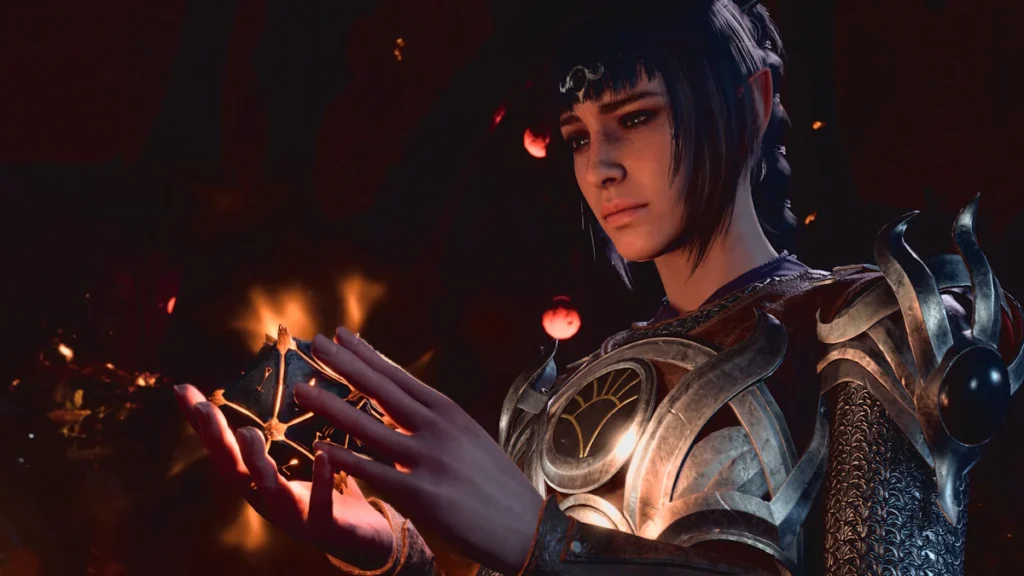
Baldur’s Gate 3 was crowned Game of the Year at The Game Awards 2023
Photo Credit: Larian Studios
Marvel’s Spider-Man 2
Insomniac Games have just about perfected the art of churning out high-production value blockbuster games that also clear a certain bar of quality when it comes to storytelling. Spider-Man 2 is no different. It pins down the soul of a Spider-Man story while maintaining an incredibly high level of polish. It takes all the good things from the previous two Spider-Man games from Insomniac and makes them just a little better. Marvel’s Spider-Man 2 does not rewrite the playbook. In many ways, it is an iterative sequel that also sticks to tried and tested open-world game design, but it attempts to curate the experience in a way that it never feels like an interminable checklist of chores.
Insomniac clearly put the emphasis on the journeys of both Peter and Miles and the people around the two Spider-Men. The web-swinging duo are the stars of the show, but side characters like MJ, Rio Morales, and Mr. Negative are portrayed with care and attention. Spider-Man 2’s villains, Lizard, Kraven, and Venom, feel fleshed out and imposing. And the expanded New York City map remains a detailed and visually stunning playground to swing around in. I found myself launching the game, even after I’d Platinumed it, just to web-swing and glide around the beautiful map.
Spider-Man 2’s combat remains elastic and fun and flexible, but it shies away from experimentation and complexity. I wish Insomniac added more depth to the fighting, instead of just throwing in a parry mechanic. Spider-Man 2’s story, too, takes the easy way out, avoiding a bolder approach and instead opting for a predictable final act. But most of the gripes are swept away by the sheer quality of the overall package. Insomniac’s Spidey sequel is visually stunning at all times, it tells a fun and engaging story, and it delivers on kinetic set-piece action moments. It’s like rewatching a good Marvel movie, where familiarity is part of the reason why you can pick it up again any time. — Manas Mitul
Buy: Spider-Man 2

The Legend of Zelda: Tears of the Kingdom
In a year packed with excellent, genre-defining games, The Legend of Zelda: Tears of the Kingdom defies categorisation. It annihilates genres to mulch and forms something entirely new from the rubble. On the surface, it’s an open-world action-adventure title with an intense focus on exploration and freedom. But when you dive into its depths, quite literally, you find it to be so much more. Tears of the Kingdom packs experiences that aren’t found in video games at all, all while being one of the greatest video games ever made.
To begin with, it throws out all the mechanical tools from Breath of the Wild right out of the window from the get-go. At first, it’s a little disorienting. But soon, the game introduces new ways to play at a measured pace, revealing new powers at Link’s disposal. When you first begin to test out the new Ultrahand ability, which lets you pick up objects in the game world and join them together to build machines, the game is careful to not overwhelm you. Your initial constructions are simple but effective. They help you cross a lake and ride a rail to reach destinations that initially seemed out of bounds. With time, Ultrahand grants you the freedom to build anything you want — a virtual Lego with unlimited blocks and unlimited imagination. You only need to go to r/HyruleEngineering to see some of the incredibly complex constructions players came up with to completely change the nature of the gameplay. From fire-spitting mechs to flying saucers, machines you build in Tears of the Kingdom are the ultimate sandbox you can experience in the medium.
No other game has surprised me as much as TotK. No other game has come even close to providing the kind of variety and freedom as TotK has. And no other game matches TotK in its commitment to creative gameplay. It’s almost as if the game hands over total control to the player, like it was a test build meant for the developers’ eyes only. Tears of the Kingdom provided me game-breaking tools and allowed me to go crazy with them. And it’s a testament to its robustness that it did not buckle under the weight of intense experimentation. And it’s not just its mechanical wonders that make it an all-time great video game. It’s the evocative music, it’s the stunning vistas and beautiful visuals, it’s the layered game world that lets you explore the skies and dive the depths, and it’s the emotional earnestness of it all that could teleport players to the first time they picked up a toy. — Manas Mitul
Buy: The Legend of Zelda: Tears of the Kingdom
Lies of P
Haters might call this a knockoff, but I think Lies of P carves its own identity in this vast pool of Soulsborne-inspired games. Sure, there are stark similarities to Bloodborne by way of the gothic atmosphere — punctuated by cobblestone streets soaked with blood and oil, fancy lamps, and piles of corpses — but it incorporates some unique mechanics to bolster its hack-and-slash gameplay. Much of this is tied to the lore, which puts you in control of the infamous lying puppet boy Pinocchio, who must unravel the secrets behind a pestilence that’s turning all machinations into frenzied monsters. Dodge-rolling through the interconnected routes of Krat and discovering shortcuts brought flashbacks from the first time I played Dark Souls Remastered — my mouth wide open in immersion as I soaked in the winding level design that tied all key locations together.
Add to that a cast of eccentric NPCs — drawn from Carlo Collodi’s works — spewing tales of a rebellious uprising, where undervalued puppets fight back against their creators, and I was sold on this dark reimagining of a children’s classic. But for most, the highlight of a good souls-like is the punishing boss battles, and oh boy, Lies of P delivers in spades by forcing you to perfect parries to the dot and memorise patterns for what feels like eternity. Understandably, this could be frustrating for newcomers and as such, the game lets you summon spirits outside the arena, in addition to adding a slew of funnily creative weaponry; from stabbing foes with an umbrella to a giant pipe wrench for some heavy damage. Regardless of what build you choose, nothing beats the dopamine hit you get upon painstakingly beating a boss — a FromSoftware staple that developer Neowiz has managed to replicate nicely.
There are some quality-of-life tweaks as well, such as any lost souls from death can be placed outside the boss arena, the ability to regenerate healing items by exerting damage, and special icons that guide you to the next step in an NPC questline. Another thing I adore about Lies of P is how almost every character serves c-nt with their stylish 19th-century France-inspired garments; some of them emanating a strong steampunkish aura that you can’t resist dressing your Pinocchio in. Unlike most RPGs, there are no stats — or shall I say ‘strings’ — attached to clothing, so you can parade around in outlandish donkey masks, top hats, to reindeer antlers, and pair them up with some formal attire without fear of being underpowered. It feels casual in all the right places.
Neowiz completely knocked it out of the park with this release, and I’m already headed to New Game+ to scratch that never-ending Bloodborne itch! — Rahul Chettiyar
Buy: Lies of P
Dredge
On the surface, Dredge is a simple game about fishing. But dive a little deeper and this little indie gem from Black Salt Games shows up to be a profound adventure about isolation, existence, and the devils that dwell in dark waters. The game starts with you, a fisherman, reaching a small coastal town in a remote archipelago. The locals help you fix up your boat and hand you a list of fish to catch in the sea. The game follows a day-night cycle, with most of the fishing done during the daytime. Nights, on the other hand, are a different affair altogether. While it’s advisable to fish during the day, some special fish only show up at night. Out in the sea, when the sun goes down, strange creatures show up and attack you. As your panic rises in the open sea, you start hallucinating and take on nightmares head on.
As you keep finding rarer fish, you sell your catch to buy upgrades for your boat that make it faster and sturdier. You also slowly get better fishing gear to catch different kinds of fish. You must also manage resources well as your boat has limited space for upgrades and equipment. Aside from your fishing adventures, you can also take up requests and side quests from people living in coastal towns. Your adventures lead you through mysteries of the sea — ghostly ships and lost messages in bottles — as you slowly piece together bits of information to unravel the story.
Low on action and heavy on atmosphere, Dredge became my go to game to play on the Nintendo Switch in bed just before sleeping. There’s a calming quality to its quiet horror and I was drawn towards its mysteries, loading up my boat night after night and heading out to sea to fish. You don’t really know what strange phenomena you may encounter on each trip. But the best part is slowly sailing back to shore after your adventure — your boat loaded with your catch for the day, your lamp flickering in the sea breeze, and the lighthouse guiding you home. — Manas Mitul
Buy: Dredge
Dave the Diver
Getting ultra-addicted to a roguelite about ocean exploration and fishing wasn’t on my bingo card this year, but here we are. Dave the Diver largely revolves around spearfishing during the day to catch the freshest bounty and managing a local sushi restaurant by night, all of which is presented in a cutesy pixelated art style that you’ll struggle to break free of. Knowing that the gameplay loop could get tiring super fast, developer Mintrocket slowly evolves the game like a Jenga tower by adding new mechanics and character arcs without making it overwhelming. In just a few weeks into your new gig as a fisherman, you’ll have run into a full-blown otaku who helps with weapon crafting, an archaeologist studying underwater mysteries, a biology research student, and an Ash Ketchum cosplayer looking to gather digital cards based on what sealife you caught. Yep, that’s a play on obsessive Pokémon card collectors.
By gradually upgrading my suit and equipment, I got strong enough to make encounters with sharks and other perilous creatures. But back on the surface, I had veered into an even greater challenge — running multiple branches of Bancho’s sushi shop and dealing with a group of relentless dolphin poachers. So, if I wasn’t hastily running around the restaurant serving dishes and pouring matcha tea for impatient customers, I was busy hiring staff and harvesting produce and rice at a nearby farm. Things started to get really intense, so I would chill out by feeding the local cat Momo every once in a while, only to soon discover that he’s got a family in the backyard. As you’d guess, I took them in.
A lot of such smaller interactions in Dave the Diver grow into entire sidequests — be it celebrity chefs challenging Bancho, talking to some mysterious sea people, or even basic fetch missions. I never got bored throughout my playthrough and was always willing to jump back in for that one extra day of fish-hunting by even setting an alarm early in the morning before work. Safe to say, I was OBSESSED… but then Baldur’s Gate 3 launched (welp). — Rahul Chettiyar
Buy: Dave the Diver
Genshin Impact
Genshin Impact is one of the most popular free-to-play, cross-platform RPG games available today. The game grew in popularity during the COVID-19 pandemic — it was launched by publisher miHoYo in 2020 — and has since been updated with several new features, regions, characters, and enemies to the game. This year, gamers were treated to a new region on the map of Teyvat — Fontaine, while regions like Sumeru and the adjoining desert were also expanded with new bosses and domains.
Earlier this year, miHoYo added a new region in the desert that is influenced by Persia with the Gavireh Lajavard update. Gamers also gained more insight into Sumeru’s Dendro Archon, and the map was opened up even further leading to another area to the north of the desert — the new region of Fontaine.
Right off the bat, you can tell that Fontaine is heavily inspired by France, from the names of characters to locations on the map. With a new steampunk aesthetic, Genshin Impact players will have to adapt gameplay to take advantage of new features and explore new regions in the game. The game also introduced Furina, the Archon in charge of the Hydro nation.
Unlike other regions in the game, the waters of Fontaine will not let you drown when you run out of stamina. In fact, you can actually swim underwater indefinitely when you are in Fontaine — your stamina bar appears blue instead of yellow. You can also “borrow” some underwater capabilities from aquatic animals, as your character’s skills do not work while swimming.
Among the more interesting areas added to the game is the Fortress of Meropide, which is a vast prison that can be explored with primary and secondary quests. The game has also added Neuvillette, Furina, Navia, Charlotte, Freminet, and Chevreuse — new characters from Fontaine that you can acquire through the game’s gacha system. — David Delima
Download: Genshin Impact

Locations are consistently updated with new enemies, wildlife, and storylines
Photo Credit: miHoYo
Stasis: Bone Totem
Dragging the revolting themes of a David Cronenberg film thousands of feet down to the ocean floor is a frightening affair for many. But for the grieving sea-faring couple Charlie and Mac, a discovery of such horrid proportions is like striking a goldmine, with the all-consuming darkness of a secret laboratory inviting them with questions and the festering stench of rotting carcasses. As a huge fan of the literary RPG Disco Elysium, I always have a soft spot for isometric games that rely on exploration and environmental storytelling to paint the larger picture. It also helps that I’ve gotten tired of the action-heavy Dead Space-esque route most sci-fi horror games take, where fear is generated from the anticipation of a jumpscare and dim lighting. While the latter is still true for Stasis: Bone Totem, the ability to see a whole room from above urges me to explore every corner and appreciate this gory universe.
One moment I’m learning about a brain implant that uploads memories to a digital afterlife upon death, and then a few hours later, I’m literally knee-deep in a pool of blood, listening to horrifying ritualistic chants from the next room. The art style is stunningly creepy, which is amplified by pulsating effects on living pieces of flesh and particulate matter floating around in the air. The meat of this game, however, is the elaborate puzzles — almost fashioned after a metroidvania wherein you’ll often revisit locations and run around in circles to slot in the new pieces. What’s more interesting is that the lead characters — Charlie, Mac, and an animatronic bear Moses — leverage their skills in breaking objects, repairs, and hacking to work together on convoluted solutions. A lot of this can feel like trial-and-error, but it always felt safe knowing that when I’m stuck, I can simply move the items over to the next character and mess about to see what happens.
Scattered around the underwater facility are datapads, yielding unique side stories about the crude experiments and other bizarre acts committed by scientists before your arrival. All of it is detailed in a neat order — almost like a diary — so it’s easy to decipher the spine-chilling events and connect the dots to the larger tragedy at hand. That said, I do wish that logs were narrated (one robotic voice) so I could just continue playing the game as I listened to them. Besides that, Stasis: Bone Totem is a fantastic indie gem that I simply can’t stop recommending to my friends! — Rahul Chettiyar
Buy: Stasis: Bone Totem
Final Fantasy XVI
I had never experienced a Final Fantasy game before Final Fantasy XVI, so I dived into the franchise with a blank slate, not really knowing what to expect aside from some of the recurring themes the series is known for. What I got was a sweeping adventure with deep and engaging lore, an emotional story with betrayal and revenge at its heart, and one of the best combat systems in video games all year. FFXVI falters where most modern RPGs excel — it has lacklustre exploration; it has underwhelming loot and character customisation; and it barely offers any meaningful choices. But it puts all its eggs in the basket of its incredibly polished and fun combat. FFXVI boss fights are some of the most epic in video games this year.
FFXVI has an interesting story to tell, too. I found myself wrapped up in the intricacies and politics of Valisthea, the palace intrigue that interjected the action, and shifting loyalties of the land’s kingdoms. As you take on Clive’s journey, you meet friends and foes and form your own group of companions. Clive, who has been on a path of revenge, takes on a higher cause and becomes a leader of the oppressed. The sprawling story, which takes cues from Game of Thrones, spans decades and involves a host of different players at different points. The information overload could easily become overwhelming, but the Active Time Lore system, which brings up contextual information and character bios in real-time with the press of a button, keeps things palatable.
If you’ve never played a Final Fantasy title, FFXVI is an ideal and accessible starting point. Each Final Fantasy game resets the setting and characters, so you can dive in without worrying about previous titles. FFXVI doesn’t quite match up to the diverse offerings of modern RPGs, but the game’s fascinating setting, its excellent combat and monolithic Eikon battles, and its evocative musical score make it one of the best narrative-action titles released this year. — Manas Mitul
Buy: Final Fantasy XVI

Final Fantasy XVI puts you in the shoes of a brooding, likeable protagonist, Clive Rosfield
Photo Credit: Square Enix
Entertainment
Asus ROG Ally X Hands-on Impressions: Upgrades That Matter
Published
8 months agoon
August 20, 2024

When the Asus ROG Ally made its debut last year, it came with certain caveats. Yes, the gaming performance was solid, but the same didn’t apply to its battery life. And while the design and build quality held up to the competition, the thermal management did not. Asus’ handheld was surely a positive entry in the segment, but it came with crucial limitations that held it back from truly challenging the heavyweights. The ROG Ally could be an alternative to the Steam Deck, but never a replacement.
Fast forward a year, and Asus is back with another gaming handheld. The Asus ROG Ally X made its debut on June 2, just ahead of Computex Taipei. The portable gaming PC attempts to address the apparent flaws of the ROG Ally with tweaks and improvements across the board. The upgrades are small, but meaningful — the handheld’s battery capacity (80Whr) significantly improves on the original’s (40Whr), it packs more memory and more storage, and is said to have better cooling than the ROG Ally. There are other changes, as well, that make for a better handheld altogether.
Two days after its launch, the Asus ROG Ally X was present at the company’s booth on the Computex floor, where Gadgets 360 got the chance to try it out for an extended period of time. It’s hard to tell how the spec bump translates into real-world performance improvements from an early and brief hands-on experience, but first impressions can go a long way. The first thing that strikes you is the new colourway that makes the ROG Ally X — well, ironically — less striking. Now in jet black, the handheld gaming PC blends with the competition (the Steam Deck, MSI Claw A1M, Lenovo Legion Go — all come in black). The original Ally’s white colourway, while more prone to dirt and grime from your hands, did convey a distinct aesthetic.

The ROG Ally X retains the design of its predecessor and there’s little that’s changed on the front. It offers the same 7-inch full-HD (1920 x 1080 pixels) IPS touchscreen display that refreshes at the rate of 120Hz and goes up to 500 nits of brightness. The D-pad sports a more pronounced design and a new matte finish — Asus says it has a more tactile feel, as well. The face buttons are the same, too, but the company claims they are “springier.” The Taiwanese firm has fitted the handheld with new joystick modules that are said to provide more control while aiming, a smoother feel and improved durability.
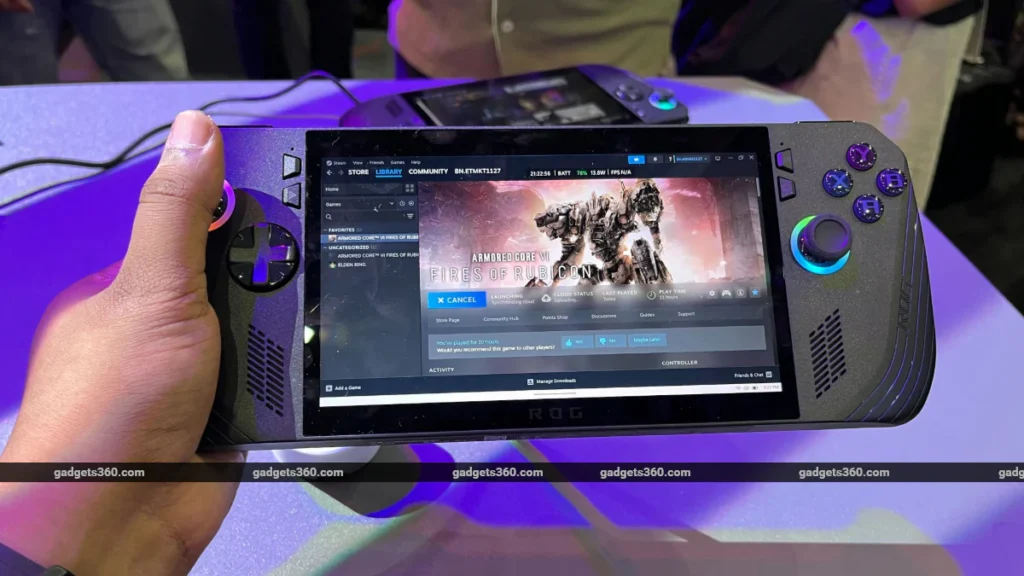
Bigger changes are, however, under the hood. The ROG Ally with its 40Whr-rated battery couldn’t last two hours while playing demanding PC titles. Its under-powered battery was perhaps the biggest flaw and prevented it from becoming a truly portable handheld. The ROG Ally X addresses that shortcoming with an 80Whr battery that should result in longer gaming sessions. Playtime numbers are not clear yet and Asus hasn’t provided details on battery performance, but these should be clear once the device is in for a detailed review.
The handheld’s memory gets an upgrade, too, the ROG Ally X gets more RAM — 24GB at faster speeds of 7500MHz, out of which 16GB will be allocated for the system and 8GB for the GPU. This should likely result in better gaming performance in general, but don’t expect a big improvement as the Ally X still runs on AMD’s Ryzen Z1 Extreme Zen 4 platform with RDNA 3 graphics, same as the 2023 ROG Ally. The new handheld also comes with bigger storage out-of-the-box — 1TB SSD with support for the more common M.2 2280-sized drives, instead of the 2230 standard used in the ROG Ally.
Ports have been repositioned, as well, and Asus has ditched its proprietary XG Mobile port for two USB Type-C ports, one of which supports Thunderbolt 4. Asus also claims it has redesigned the cooling system on the handheld. The ROG Ally X uses smaller fans, which make space for the bigger battery, but result in better airflow — about 24 percent more than the previous model, according to Asus. This is also claimed to bring down the touchscreen temperature by up to 6 degree Celcius. The 2023 model did struggle with heat management, so this is a welcome change. But real-world thermal performance would only be clearer upon extended use.

The one big thing that held back the Asus ROG Ally and works against the new model as well is the OS. The ROG Ally X comes with Windows 11, which while offering flexibility and versatility, remains an unwieldy and unintuitive touch interface for touchscreens. Sure, it allows the handheld to work like a pocket PC with attached controllers, but it pales in comparison to Steam Deck’s SteamOS, which brings a smoother, console-like UI. Asus has, however, packed a new version of Armoury Crate SE software this time around, which promises a more customisable interface and game library with easier navigation.
At Computex, Gadgets 360 tried out games like Armored Core VI: Fires of Rubicon, Palworld, and Tekken 8. The titles were running smoothly, and we did not notice overheating issues in the short time with the handheld. This stood in contrast to the hands-on experience with the Zotac Zone, another new handheld seen at Computex. Zotac’s Windows-based portable crashed while running Horizon Forbidden West and showed signs of overheating. A detailed review will shed more light on the new Ally X’s gaming and thermal performance, but considering the improvements brought to an already decent handheld, the ROG Ally X could become the easiest to recommend among its Windows-based peers.

The upgrades, however, also come at a cost. The Asus ROG Ally X costs $799 (roughly Rs. 66,700), up a $100 from the Z1 Extreme version of the 2023 model. India pricing should be available closer to launch here, which Asus has said should happen later this year. And while all the upgrades bring meaningful improvements, an OLED screen, too, would have been a nice addition. But, taking the price point into consideration, it seems Asus has made all the right choices for a mid-gen refresh of its handheld. The verdict can wait until a detailed review, but the ROG Ally X left us impressed in our hands-on time with the handheld. It might not be a true successor to the 2023 model, but it looks like a success.
Disclosure: Asus sponsored the correspondent’s flights and hotel for the event in Taipei.

ChatGPT: Here’s All You Need to Know About the AI Chatbot

GPT4 game changer features in 2024

ICANN Reserves ‘.internal’ Domain for Private Use—Here’s Why

ChatGPT: Here’s All You Need to Know About the AI Chatbot
Senua’s Saga: Hellblade II Review: Ninja Theory’s Flawed, but Uncompromising Sequel Is a Cinematic Achievement
How to Use Twitter’s New Bitcoin Tipping Feature
Trending
-

 Business7 months ago
Business7 months agoChatGPT: Here’s All You Need to Know About the AI Chatbot
-
Entertainment8 months ago
Senua’s Saga: Hellblade II Review: Ninja Theory’s Flawed, but Uncompromising Sequel Is a Cinematic Achievement
-
Cryptocurrency8 months ago
How to Use Twitter’s New Bitcoin Tipping Feature
-
Business8 months ago
Database Admins See Brighter Job Prospects Amid IT Challenges
-
Business8 months ago
Bitcoin Price Crosses $61,000, Most Altcoins See Profits as Market Shows Signs of Stabilisation
-
How-To8 months ago
How to Add Links to Your Instagram Stories
-
Computer8 months ago
How to Enable Chrome Dark Mode on Android, iPhone, Windows, Mac
-
Entertainment8 months ago
Lenovo Legion Go Review: Best Windows Handheld?
-

 Computer7 months ago
Computer7 months agoIs a ChatGPT Plus subscription worth it?
-

 Business7 months ago
Business7 months agoGPT4 game changer features in 2024
-
Business8 months ago
How to Check ITR Filing – IT Return Status Online
-
Artificial Intelligence (AI)8 months ago
How to avoid online scams and what to do if you become a victim
